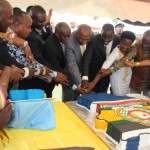Somalia intends to resume printing banknotes this year for the first time since the government collapsed in 1991.
The governor of Somalia’s central bank, Bashir Issa Ali, said in an exclusive interview that all technical preparations are complete, and his government is confident it can assemble a financial aid package within three months to fund the printing program. Further work would take another four months.
Asked if Somalia will print and distribute banknotes during 2017, Ali answered: “Absolutely. Absolutely. Absolutely!” He pledged the new currency would include “good, reliable security features.”
Pre-1991 banknotes have disappeared from Somali markets, replaced by either Western currencies, including dollars, or privately printed notes, most of which are worthless fakes.
Ali said international institutions, such as the World Bank and the International Monetary Fund, as well as the US Treasury, have been helping Somalia reform its financial sector and train central bank staff.
Outgoing Somali President Hassan Sheikh Mohamud met a key demand of the international community last year by signing into law parliament-approved legislation to outlaw money laundering and ‘financial terrorism’.
The Somali government needs $60 million to be able to begin printing banknotes. Ali said he expects to obtain pledges for that sum at an international donors’ conference for Somalia in London in May.
“We expect the international community to assist us with that issue,” the bank governor said.
Hardship and the scarcity of trustworthy currency has created opportunities for some innovative strategies in the private sector, Ali said, and Somalia has made some progress in establishing private banks and mobile money systems.
Many transactions in Somalia now take place using “electronic mobile money,” Ali added.
Somali shillings account for a small portion of the payments system, he said.
“Most of it is done through dollars and electronic money, which is a great thing for … saving costs and effort and very convenient, also.”
Remittance companies that relay payments from Somalis working abroad operate in many parts of the country Ali noted, but a large part of the nation does not have access to electronic funds or dollars, so there is an urgent need for a reliable national currency.
Meanwhile, in the short term, the peaceful election of a new Somali president appears to have helped the nation’s economy. The Somali shilling rose in value compared with the US dollar over a two-day period; US$1 brought 22,000 shillings before the election in Mogadishu but by Saturday it was trading at 16,000 shillings.
In a related development the new President Mohamed Abdullahi Farmajohas temporarily suspended withdrawals from accounts of government departments until the incoming cabinet is formed.
According to Sources, he has issued an order to suspend withdrawal from the accounts in central bank and private banks in Mogadishu.
The suspension of central bank withdrawals came following a meeting between President Farmajo and central bank governor Bashir Isse Ali on Saturday night.
“All government accounts at the central bank and private money transfer companies were temporarily frozen after an executive order from the new President,” said an official who asked not to be named.
This comes as the new President is set to be inaugurated next week in Mogadishu and take over the office from his predecessor Hassan Sheikh Mohamud, who has been in power since 2012.
The move is reportedly aimed at preventing embezzlement and assets misappropriation during power transfer period. In the past four years, a colossal amount of money was reported to have been stolen from the central bank of Somalia.







